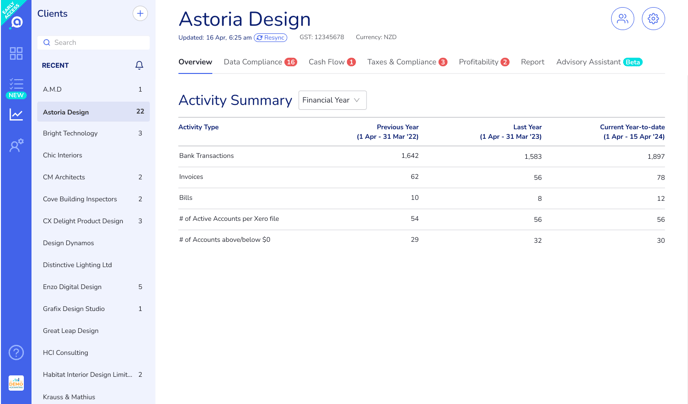The client Activity Summary gives you an overview of the client's key Xero activity statistics for the current period to date + two previous period. You can choose between summaries for the financial year or for the GST period.
Use the client's Activity Summary to help you:
- Gauge the cost to serve a client and price your service accordingly.
- Plan your staffing, workload, and client expectation management to avoid burnouts.
- Get an indication of how your advisory client is doing based on the trend in the volume of key Xero activities.
You can find this summary on the "Overview" tab of a client in the Client Insights section.
 |
How the client's Activity Summary is calculated
| ACTIVITY | DATA SOURCE |
|
Bank transactions |
“Spend” and “receive” bank account transactions |
|
Invoices |
Invoices |
|
Bills |
Bills |
|
# of Active Accounts per Xero file |
Chart of accounts. |
|
# of Active Accounts above/below $0 |
Profit and Loss report, Balance Sheet report. |
FAQ’s:
Q: How do I compare Aider’s Activity Summary with corresponding data in Xero ?
A: You can find the corresponding data in Xero as follows:
- Bank transactions:
Go to Account Transactions report >
select all active bank accounts >
select the matching date range >
select “Filter - Source: Receive Money, Spend Money” >
apply update.
Check the total number of items (“Showing items 1-10 of T”) at the bottom of the screen. - Invoices:
Go to Invoices >
click Search >
select “Search Within: Translation date” >
select the matching date range >
select “Include Deleted & Voided” >
apply search.
Check the “total items” number of items at the bottom of the screen. - Bills:
Go to Bills >
click Search >
select the matching date range >
select “Date type: Translation date” >
select “Filter - Deleted & Voided: Show”.
Check the total number of items (“Showing items 1-10 of T”) at the bottom of the screen. - # of Active Accounts:
Go to Chart of accounts.
Check the “total items” number at the bottom of the screen. - # of Accounts above/below $0:
Go to Profit and Loss report + Balance Sheet report >
select the matching date range >
apply update.
Count and add up the number of accounts with figures above or below $0 from both reports.
